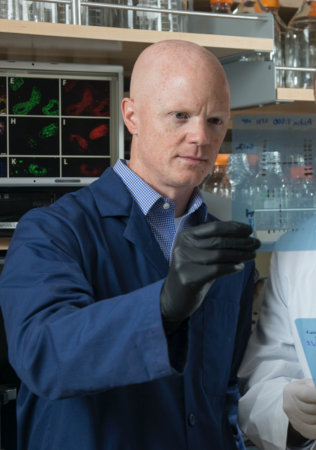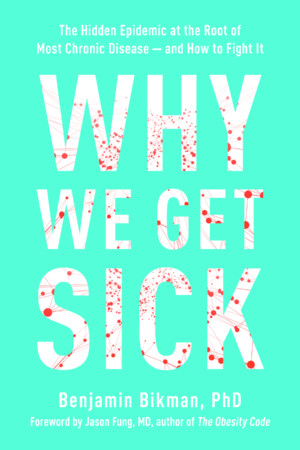When I entered the empty-nester chapter of life, I started focusing on factors leading to a healthier lifestyle. Books and articles about longevity and ways to avoid illness became a priority. The COVID-19 pandemic has heightened my quest to minimize risks for medical issues. Media outlets repeatedly single out the connection between pandemic hospitalizations/mortality rates and people with underlying health issues. Intermingled in these reports are the medical terms— hypertension, diabetes, heart disease, obesity, cancer, and respiratory illnesses. This sobering news is a wake-up call. To remain healthy, it is imperative to understand what increases the odds of getting sick.
When I searched for soon to be released books, I came across Dr. Benjamin Bikman’s book, Why We Get Sick. Bikman is a Brigham Young University scientist and biomedical professor whose expertise is in bioenergetics and metabolic disorders. Unlike many authors who write on this topic, Bikman is not a medical doctor. He has a PhD.
After reading through an advanced review copy of Why We Get Sick, scheduled to be released this month, I understand why Bikman feels that many of today’s chronic medical disorders—cancer, heart disease, high cholesterol Alzheimer’s disease, vascular dementia, Parkinson’s disease hypertension, as well as many others are linked to insulin resistance. His analysis is backed up with more than 30 pages of endnotes chronicling an abundance of research in multiple disciplines along with his scientific understanding of how the body works.

Introduction
In the Introduction, Bikman emphatically states that “insulin resistance is the most common health disorder worldwide, and it affects more people—adults and children—each year than any other. (Page xv) Like many other people, I previously understood the connection between insulin resistance and diabetes and Alzheimers. However, I didn’t fully appreciate how insulin levels can affect the entire body. Bikman effectively points out why diabetes and Alzheimers are only a small part of the story.
Part One
Bikman explains the role of insulin in the body and how insulin resistance stands side by side with almost every chronic disease. It affects heart health, the brain, and neurological disorder, reproductive health, cancer, skin, muscles and bones, the GI tract and kidney health, obesity, and metabolic syndrome. Readers can easily move from one chapter to the next by scrolling through well-organized headings, subheadings, graphs, and highlighted sidebars to find information relevant to their situation.
He intertwines facts with clear explanations of current medical research. These kernels of information will make most people pause briefly. Perhaps, relevant statements will create an opportunity to evaluate daily choices, especially when such a high percentage of people have insulin resistance. Diet and activity levels are directly related to health status.
The following statements highlight a cross-section of some of these important facts:
“…half of all U.S. adults, and roughly one in three Americans are know to have it. However, this number could be as high as 88% of Americans. (Page 3)
“from the brain to the toes, insulin regulates how a cell uses energy, changes its size, influences production of other hormones, and even determines whether cells live or die.” (Page 4-5)
“…insulin resistance and cardiovascular disease are almost inseparable.” (Page 13)
“…insulin resistance and high insulin levels directly cause high blood pressure.” (page 14)
“First, insulin resistance increases blood pressure increasing the likelihood of blood vessel damage. Next, it increases lipid deposition in blood vessel walls. Finally, insulin resistance increases inflammation, promoting the ongoing infiltration of the blood vessel with macrophages, which become increasingly laden with oxidized lipids, changing into foam cells.” (page 22)
“The brain’s inability to get enough glucose is a cardinal feature of Alzheimer’s disease. As in our muscles, insulin facilitates the movement of glucose into the brain. However, as the brain becomes progressively insulin resistant, it becomes less and less able to obtain enough glucose to meet its energy demands. So, like an engine running on empty, the brain doesn’t work well.” (Page 29)
“…vascular dementia occurs because the brain suffers from insufficient blood flow…subjects with insulin resistance have about twice the risk of developing vascular dementia compared with insulin-sensitive subjects.” Page 30)
“Up to 30% of patients with Parkinson’s disease have type 2 diabetes, with possibly up to 80% having insulin resistance or prediabetes.” Page 31)
“…cancer is a disease of cellular growth; certain cells begin to multiply uncontrollably. And insulin resistance is part of this equation, because it pushes cancer cells to grow faster.” (Page 51)
“Almost 100 years ago, the German physician and scientist Otto Heinrich Warburg discovered that cancer cells have an almost total reliance on glucose as their primary metabolic fuel.” (Page 52)
“…people with hyperinsulinemia—whether they are lean or fat—have roughly double the likelihood of dying from cancer.” (Page 52)
“…patients who are insulin resistant are much more likely to experience a reduction in bone mass when compared to insulin sensitive individuals.” (Page 65)
“A shocking number (about 63%) of people with insulin resistance (type 2 diabetes) experience gastrointestinal issues. It’s also the leading cause of kidney failure.” (Page 69)
“Being insulin resistant is the strongest known predictor of developing NAFLD (nonalcoholic fatty liver disease), increasing the risk of having it by 15 times compared with an insulin sensitive person. (Page 75)
“Multiple human studies found that insulin resistance is one of the most significant risk factors for developing gallstones.” (Page 77)
“…high blood insulin increases the amount of blood calcium. Too much calcium can cause various problems, including affecting the heart: calcium also forms the most common type of kidney stone.” (Page 79)
“…the most insulin resistant people have a four times greater risk of developing kidney failure than those with mild insulin resistance.” (page 80)
“The World Health Organization defines metabolic syndrome by two main criteria: first, the patient must have two of either high blood pressure, dyslipidemia, central obesity, or low levels of protein in the urine; and second, the patient must have insulin resistance.” (Page 81)
“When it comes to body fat, the hormone insulin is the critical factor—if insulin is up, body fat goes up; if insulin is down, body fat goes down.” Page 85)
Part Two
After becoming well versed in different ways that insulin resistance adversely affects the body, I was eager to read Part Two where Bikman describes the five main reasons (age and genetics, hormones, obesity, inflammation, and oxidative stress, and lifestyle factors) why people become insulin resistant. While factors such as the aging process, ethnicity, and genetics put people at greater risk, lifestyle choices (food choices and active lifestyles) can minimize the full effect.
People who are able to control their stress levels will undoubtedly have lower cortisol levels while others with above normal cortisol levels will have elevated blood glucose levels and more visceral fat. “Study after study has shown that storing fat inside the core of the body is harmful, and we now know that there are differences in how fat behaves when it’s stored in the viscera.” (Page 104) This type of fat increases the risk for abnormal levels of inflammation and oxidative stress. The air we breathe, the foods and beverages we consume along with our sleep patterns and daily activity levels also affect our insulin levels.

Part Three
In the last part of the book, Bikman encourages people, whenever possible, to consider lifestyle changes instead of merely treating symptoms. Even though many doctors prescribe drugs and surgical intervention, these options do not address the underlying cause. Instead, Bikman suggests ways to minimize and/or reverse insulin resistance. His recommendations to include resistance training and intensity workouts into a weekly exercise program are backed up by medical studies.
In Appendix A, Bikman offers an easy to follow exercise plan. His guidelines may be useful to some readers who are looking for a starting point. Individuals seeking a more comprehensive program should look to other resources. I agree wholeheartedly with Bikman’s common sense statement, “the best exercise to help improve your insulin sensitivity (or achieve any health outcome) is the one you will actually do.” (Page 179)
Before making his dietary suggestions, Bikman outlines the drawbacks to a handful of popular ways to modify diets. He goes on to explain how intermittent fasting can improve insulin sensitivity, the role that certain types of carbohydrates play in spiking insulin, and how food choices can affect oxidative stress and inflammation.
Considerable time is spent discussing how foods affect insulin resistance and which foods should be included in an optimal diet. Near the end of the book, he lists four critical elements for a healthy diet that will keep insulin levels within a normal range—control carbohydrates, prioritize protein, fill with fat, and watch the clock. (Page 183) Additional information about food is found in Appendix B. The last page of the book offers a list of books and online resources.
There is little doubt that insulin resistance is a serious health concern. It has the potential of affecting the entire body and may make it more difficult to recover from sicknesses such as COVID-19. Bikman shares a plethora of data supporting the contention that it is possible to reverse the process by making personal choices. He offers a variety of tools to help readers make wiser food choices and healthier lifestyle decisions. While many of his concerns have been voiced by others, it is useful to read books coming from multiple perspectives. Since everyone is unique, certain lifestyle changes may be more effective for some people and not for others.
To learn more about Dr. Bikman and his research, read Q & A With Dr. Benjamin Bikman.
DISCLOSURE
I received a complimentary copy of Why We Get Sick.
RELATED POSTS
Q & A with Dr. Benjamin Bikman
Eat to Beat Disease and Glioblastoma
Should Glioblastoma Patients Investigate Radical Remission?
Can Your Diet Influence COVID-19 Immunity?
5 Ways to Improve Exercise Motivation
Perseverance Leads to Successful Recovery
How Do I Become Motivated to Live a Healthy Life
BIO
Sandra Bornstein is the author of May This Be the Best Year of Your Life. Sandra’s memoir highlights her living and teaching adventure in Bangalore, India. She was a licensed Colorado teacher who taught K-12 students in the United States and abroad. Sandra also taught college-level courses at Front Range Community College and the University of Colorado-Boulder.
In addition to reviewing books and interviewing authors, Sandra is an award-winning author and lifestyle and travel journalist. Many of Sandra’s travel stories appear on the For Readers Page. To follow Sandra’s travel adventures, visit TheTravelingBornsteins website.

Connect with Sandra